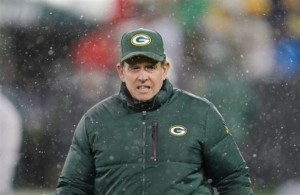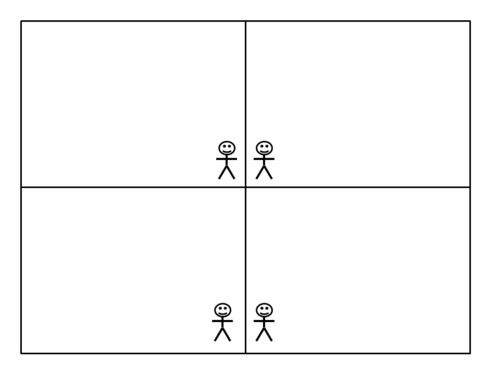

Green Bay Packers defensive coordinator Dom Capers brought the zone blitz defense with him when he was hired in 2009. Despite playing less zone blitz in recent years in favor of traditional man-to-man blitz packages, the Packers still utilize a fair proportion of zone coverages.
This article will look at some of the basics of zone pass coverage. It is frequently described as covering an area instead of an individual player.
That definition is partially true, but the technique of zone coverage is more complex that that. In fact, it utilizes man-to-man principles. The difference is pure man-to-man coverage has the defender covering the man anywhere on the field. In zone coverage, the defender covers the man only within the area of the field he’s assigned to cover.
Last week we looked at man-to-man coverage. Click here for a refresher.
Why Play Zone Coverage?
There are several reasons teams play zone coverage. The most common reason is because it allows the defense to cover more talented or faster offensive players. If their players are better than yours, it’s recommended you play zone.
Zone usually has “layers” of protection, which means a defender typically has help in some capacity. If he gets beat, chances are someone else behind him can prevent a scoring play.
From a schematic standpoint, zone provides several advantages over man-to-man coverage. While playing man-to-man, the defender usually has his back turned to the quarterback and the ball. In addition to not seeing the ball leave the quarterback’s arm, the defender also cannot see the quarterback scramble for long gains. While playing zone, the defender is often facing the quarterback and ball.
Overall, while playing zone, the play should always be “in front” of the defense and they can react to the ball in an attacking manner.
Essentially, while playing zone, the offense must beat the entire defensive scheme, but when playing man-to-man coverage, the offense must only beat one defender.
We’ve all heard the expression, “No chain is stronger than its weakest link.” Well, in team defense, the worst defender is the weakest link. Zone helps minimize weaknesses and overcomes the idea of “No defense is stronger than its weakest player.”
Assigning a Zone
There is tremendous variation in creating a zone coverage. However, the bare basics of it are universal. A defender is assigned an area of the field to cover. At the snap of the ball, the defender must first determine if the play is a run or pass.
If the play is a pass, the defender must backpedal to the assigned landmark. This can be a yard line, a number, a hash mark, or a predetermined number of steps. Typically, the landmark puts the defender in the geometric center of the zone. No matter what the landmark is, it’s to ensure the defender gets proper depth.
Playing the Zone
Once the defender has reached his landmark, he must now guard the entire area he’s been assigned. If an offensive receiver enters the area, the defender then guards him in man-to-man fashion. The defender typically drives downhill towards the receiver in anticipation of a pass being thrown to him.
If the ball is being thrown into his zone, the defender must defend the pass. If the receiver leaves the zone without the ball or a pass being thrown, the defender must release the receiver. That receiver then becomes the responsibility of the next zone’s defender.
Then, the new defender drives toward the receiver and the previous defender returns to the landmark.
In principle, zone makes it easier for each defender. Rather than following a receiver over the entire field, he must only follow the receiver over a shorter area. He’s also not concerned with other receivers in other areas of the field.
Zone also allows each defender the potential to defend different receivers at different times. For example, if one receiver leaves the zone and then a new one enters, the same defender ended up covering two receivers without running all over the field to do so.
Zone as a Total Team Concept
Let’s put everything thus far together. In the GIF below, I created a simple four area zone using four defenders.
At the snap off the ball, you’ll see them backpedal to their landmark. Then, follow the first receiver through the zones and watch how each defender reacts to him. After watching the first receiver, watch the scheme allow the coverage of a second receiver. Notice how the entire defense works together to cover the receivers.
This breakdown may seem pretty basic, which is because the principle of zone coverage is fairly straightforward.
But, I wanted to start quite basic first so I can build upon this to show different zone coverage shells, and also how specific route combinations attack zone schemes.
We have to start small before we go bigger and more complex. Stay tuned over the next few weeks when I start opening up the playbook.
——————
Jay Hodgson is an independent sports blogger writing for AllGreenBayPackers.com and WISports.com.
——————





Thanks, Jay.
I am really enjoying this series. While this was pretty basic I appreciate that you are setting a foundation for more.
Love the stick figures. Were those modeled after Jennings or McMillian?
I like that they’re out there having a good time, smiling. They’re like little Sterling Sharpe’s.
Definition of Zone defense = We have piss poor DB’s and we are very frightened by your recievers…
If two receivers come into your zone that can be a problem. I would assume you go with the deeper man, but what if you’re playing two-deep and two come into the deep zone? I’m hoping this year we have a safety (Hyde, presumably at this point) who can handle this better than our stable did last year. I think part of Burnett’s problem last year was that he had to too much to do because of the poor play at the other safety spot. Sure hope Hyde is in the film room!
Good concept. Depends upon having something that looks like a pass rush and defense backs that are not running up trying to stop the run, or a foot shorter than the receiver and two or three steps slower. For the packers man to man or zone it doesn’t matter because they do not have that talent to work either at this time.
does it matter what we scheme if we cant tackle should be #1 consern
Somebody actually explained something basis instead of just assuming that all his readers would know what all the basics are. I think I like this guy.
Some of the very best “Zone” team defense I’ve ever seen played was Lovie Smith’s Chicago team’s with Urlacher in his prime, they would get 6 or 7 guys to the football on almost every play, force u to throw short and then rally to the ball. I know they gave GB lots of problems for several years. There is something to be said for having all those eyeballs on the QB.